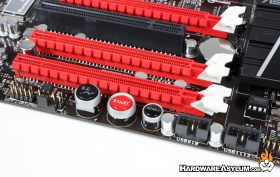Asus Crosshair V Formula Motherboard Review
Author: Dennis Garcia
Published: Tuesday, October 11, 2011
Board Layout and Features Cont.
Dual channel memory comes standard with current Phenom processors and the Crosshair V Formula supports up to 32GB of DDR3 memory at speeds up to 2133Mhz. The 2133Mhz implies that current Sandy Bridge approved modules are supported but for the best performance be sure to look for Phenom tuned modules as well.
Near the memory sockets you will find a series of voltage test points used mostly for overclocking and the famed "Go" button. This button serves a dual purpose by enabling the MemOK POST feature before the system boots. Then after the OS has loaded the button will allow you to load overclocking profiles based on what you have configured in the system.
Near the memory sockets you will find a series of voltage test points used mostly for overclocking and the famed "Go" button. This button serves a dual purpose by enabling the MemOK POST feature before the system boots. Then after the OS has loaded the button will allow you to load overclocking profiles based on what you have configured in the system.
Much like on the Rampage III Extreme you will only find a single debug LED which consists of four LED lights. Each light will indicate when a certain section of the motherboard have initialized. You'll find these lights near the 24pin power connector which will also be hidden depending on how you route your cables.
An enthusiast ready motherboard is never complete unless you have a few benchtop buttons to control the power and reset. We are happy to say that the standard ROG buttons are present on the Crosshair V Formula along with a 3rd button simply labeled O.C.. As you can imagine pressing this button will overclock your system without needing to alter anything in the BIOS or thru the included software.
An enthusiast ready motherboard is never complete unless you have a few benchtop buttons to control the power and reset. We are happy to say that the standard ROG buttons are present on the Crosshair V Formula along with a 3rd button simply labeled O.C.. As you can imagine pressing this button will overclock your system without needing to alter anything in the BIOS or thru the included software.
The front panel controls are located in the standard location near the bottom right of the motherboard and occupy the same space as the two BIOS chips and iROG controller chips. There are a total of eight PWM fan connections with two of them located here within easy reach of front mounted case fans.
The I/O on the Crosshair V Formula is quite fun and features a single PS/2 connector for keyboard and mouse, a total of eight USB 2.0 ports and four USB 3.0 ports, a single Gigabit Ethernet connection, eSATA (in red), 8 channel analog audio and a single S/PDIF optical connection, ROG connect button with USB port and CMOS reset switch.
The I/O on the Crosshair V Formula is quite fun and features a single PS/2 connector for keyboard and mouse, a total of eight USB 2.0 ports and four USB 3.0 ports, a single Gigabit Ethernet connection, eSATA (in red), 8 channel analog audio and a single S/PDIF optical connection, ROG connect button with USB port and CMOS reset switch.
Internal SATA connections number seven that all follow the new SATA6 connection standard. Six of these ports are directly connected to the AMD SB950 chipset. The seventh and single eSATA connection is part of an ASMedia controller tasked with providing USB 3.0 support to the motherboard.







